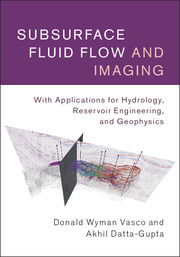 Subsurface Fluid Flow and Imaging
Subsurface Fluid Flow and Imaging Published online by Cambridge University Press: 05 July 2016
Introduction
Diffusive processes are often assumed to have very little in common with solutions of the hyperbolic partial differential equations governing wave-like propagation. Indeed, solutions of the diffusion equation decay in an exponential fashion with distance from the source of a disturbance. Thus, to propagate an observable disturbance away from a source it is often necessary to continuously supply mass or energy. For example, in order to propagate an observable pressure disturbance from an injection point to a distant location it is typically necessary to introduce fluid at a constant rate into the porous medium for a sustained period of time. However, as indicated in Chapter 1, transient solutions to the diffusion equation do indeed propagate, and, as will be shown in this chapter, one may derive an expression governing the phase of such a propagating disturbance. The governing equation for the phase is a Hamilton–Jacobi equation, identical in form to the eikonal equation encountered earlier. However, the interpretation and the effect of the phase function is significantly different from that of a propagating wave, in keeping with the very different nature of diffusion. In this chapter we shall consider one approach for developing a trajectory-based solution for diffusion equation, a high-frequency asymptotic expansion. We shall illustrate the approach and its utility with a few applications, including diffusion tomography.
A high-frequency asymptotic solution
Here we derive a high-frequency asymptotic solution for the diffusion equation. The phrase ‘high-frequency’ is not commonly associated with diffusive processes. However, a high-frequency component is present in the early rapid variations of pressure due to the onset of fluid injection. Also, the notion of what constitutes a high frequency is relative to the temporal variation of the background field, which can be gradual. Admittedly, the approximation does not have the long reach associated with processes such as elastic wave propagation and is often restricted to a region surrounding the source. Still, the range over which we can utilize a transient pressure disturbance is far enough to provide a powerful tool for imaging flow properties between a given source and receiver. Furthermore, our asymptotic analysis allows us to draw a connection between the well developed modeling of wave propagation and transient solutions to the diffusion equation. Such a connection is useful in understanding coupled processes and equations of a mixed nature: those that are neither entirely wave-like nor completely diffusive in character.
To save this book to your Kindle, first ensure [email protected] is added to your Approved Personal Document E-mail List under your Personal Document Settings on the Manage Your Content and Devices page of your Amazon account. Then enter the ‘name’ part of your Kindle email address below. Find out more about saving to your Kindle.
Note you can select to save to either the @free.kindle.com or @kindle.com variations. ‘@free.kindle.com’ emails are free but can only be saved to your device when it is connected to wi-fi. ‘@kindle.com’ emails can be delivered even when you are not connected to wi-fi, but note that service fees apply.
Find out more about the Kindle Personal Document Service.
To save content items to your account, please confirm that you agree to abide by our usage policies. If this is the first time you use this feature, you will be asked to authorise Cambridge Core to connect with your account. Find out more about saving content to Dropbox.
To save content items to your account, please confirm that you agree to abide by our usage policies. If this is the first time you use this feature, you will be asked to authorise Cambridge Core to connect with your account. Find out more about saving content to Google Drive.